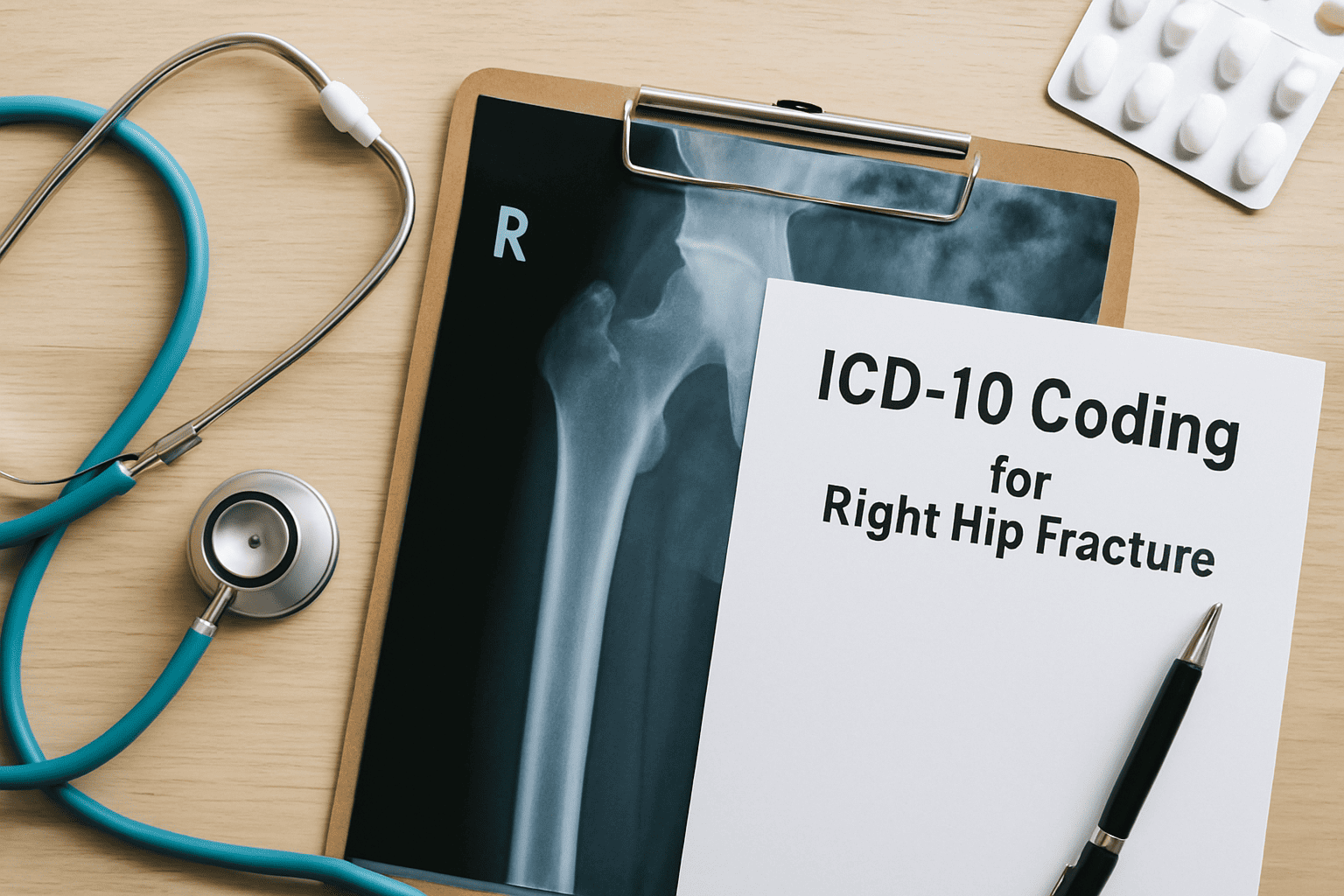Updated on: July 21, 2025
Fractures of the hip, particularly the right hip, are among the most common orthopedic injuries—especially in older adults. Accurate documentation and ICD-10 coding are crucial not just for proper reimbursement but also for ensuring seamless care continuity, surgical planning, and risk adjustment. Whether you’re a clinician, orthopedic surgeon, coder, or part of a hospital revenue cycle team, understanding codes like S72.001A and S72.141A is essential.
In this guide, we’ll break down what these ICD-10 codes mean, when to use each, and how AI medical scribes like Docscrib can help streamline your documentation and improve coding accuracy.
Understanding the ICD-10 Codes: S72.001A vs S72.141A
What is S72.001A?
-
S72.001A refers to:
Fracture of unspecified part of neck of right femur, initial encounter for closed fracture. -
Used when:
-
The fracture is localized to the femoral neck but without precise specification.
-
The initial encounter is being coded (i.e., active treatment phase).
-
The fracture is closed (no break in the skin).
-
What is S72.141A?
-
S72.141A refers to:
Displaced intertrochanteric fracture of right femur, initial encounter for closed fracture. -
Used when:
-
The fracture is at the intertrochanteric region (between the greater and lesser trochanters).
-
The bone fragments are displaced (not aligned).
-
This is the initial treatment encounter.
-
The fracture is closed.
-
Key Differences:
| Code | Region | Displacement | Specificity | Encounter Type | Fracture Type |
|---|---|---|---|---|---|
| S72.001A | Unspecified femoral neck | Unknown | Low | Initial | Closed |
| S72.141A | Intertrochanteric (right femur) | Displaced | High | Initial | Closed |
Why Accurate ICD-10 Coding Matters in Hip Fractures
✅ Billing & Reimbursement: Using a general or incorrect code can lead to claim denials or underpayments.
✅ Clinical Specificity: Codes like S72.141A provide granular detail essential for surgical planning.
✅ Data Analytics: Accurate codes feed into national trauma databases, EHR analytics, and value-based care models.
✅ Legal Protection: Clear documentation helps support the level of care provided in case of audits or litigation.
How Docscrib Helps Improve ICD-10 Coding Accuracy
AI medical scribes like DocScrib are transforming orthopedic documentation by:
🔍 Real-Time Fracture Recognition
DocScrib listens to the provider-patient encounter and identifies contextual clues—such as anatomical location, displacement, and laterality—to suggest the correct ICD-10 code.
🧠 Contextual AI Matching
Our system uses AI-powered clinical intelligence to recommend precise codes like S72.141A when intertrochanteric fractures are mentioned—even if the language is conversational or varies across providers.
📋 Auto-Populated Notes with Coding Precision
From SOAP notes to discharge summaries, Docscrib auto-generates structured documentation that integrates ICD-10 codes directly into the EMR—reducing coding errors and freeing up clinicians’ time.
✅ Want to see how Docscrib can improve orthopedic coding accuracy and reduce charting time?
Book a Demo
Common Clinical Scenarios and Coding Tips
Scenario 1: Elderly Patient Falls at Home
Diagnosis: Intertrochanteric fracture of right femur
Code: S72.141A
💡 Tip: Always mention “displacement” and “laterality” in the HPI.
Scenario 2: Ambiguous Hip Pain Post-Injury
Diagnosis: Right femoral neck fracture, unclear location
Code: S72.001A
💡 Tip: Use this only if specific location (e.g., intertrochanteric or subcapital) is not documented.
Scenario 3: Follow-Up Visit Post-Surgery
Code Format: Change the 7th character to D (subsequent encounter). E.g., S72.141D
💡 Tip: Always update the 7th character based on encounter type:
-
A = Initial encounter
-
D = Subsequent
-
S = Sequela
How to Document for Maximum Coding Accuracy
To ensure you’re using the right ICD-10 code for a right hip fracture, include the following in your documentation:
-
✅ Laterality (Right vs Left)
-
✅ Specific location (Intertrochanteric, Femoral neck, Subtrochanteric)
-
✅ Type of fracture (Displaced vs Non-displaced)
-
✅ Encounter type (Initial, Subsequent, Sequela)
-
✅ Open vs Closed fracture
Docscrib’s AI makes this easier by prompting for missing details and suggesting structured phrases while the clinician speaks.
Final Thoughts
Choosing between S72.001A and S72.141A might seem trivial, but these codes carry significant clinical and financial weight. In today’s value-based care environment, coding specificity matters more than ever.
By using AI-powered medical scribe tools like DocScrib, clinicians can document more accurately, code more precisely, and focus more on care than charting.
Frequently Asked Questions (FAQs)
What’s the difference between S72.141A and S72.001A?
S72.141A is a specific, displaced intertrochanteric fracture code; S72.001A is a general, unspecified femoral neck fracture code.
Can I use S72.001A if I suspect a right hip fracture but don’t have imaging yet?
Yes, but update it once a more definitive diagnosis is available. Use of unspecified codes should be minimized.
Does Docscrib support ICD-10 coding prompts during dictation?
Absolutely. Docscrib’s AI analyzes real-time dictation and recommends precise ICD-10 codes with full documentation support.
How does Docscrib improve orthopedic workflows?
From recognizing fracture descriptors to auto-generating encounter notes with CPT and ICD-10 codes, Docscrib reduces documentation time and boosts accuracy.
Where can I try Docscrib for my clinic?
👉 Book a free personalized demo now
Explore Docscrib – your AI partner for orthopedic documentation and accurate ICD-10 coding.
Visit DocScrib.com to learn more.
